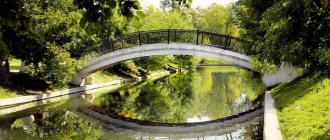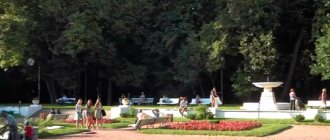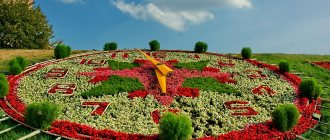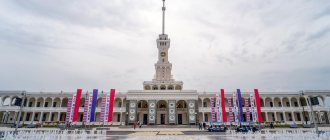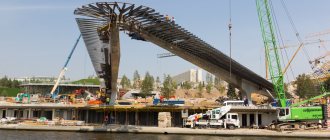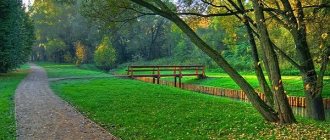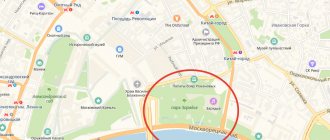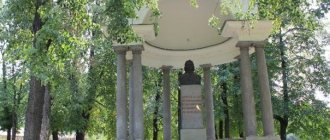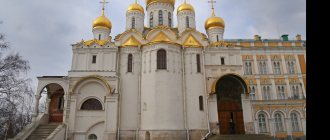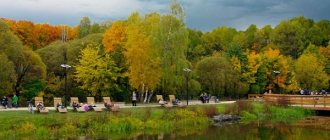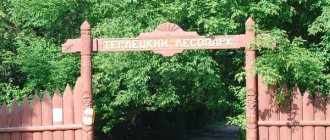Timiryazevsky Park is one of the most beautiful natural areas of Moscow. A real forest, with lush trees and greenery. A deserted, calm, slightly gloomy, but infinitely peaceful space in a stone sack of a metropolis.
Timiryazevsky Park - an ancient forest park from the time of Peter I
Ancient park named after. K. A. Timiryazeva is a forest park in the north of Moscow. Its area is 232 hectares. The park territory is federal property.
General information about Timiryazevsky Park
Timiryazevsky Park, on the territory of which the Moscow Agricultural Academy is located. Timiryazev, is located in the Timiryazevsky district of the Northern Administrative District of Moscow. The area of the park is 232 hectares. The park territory is federal property. The park is part of the Petrovsko-Razumovskoye Complex Reserve, which in addition to it includes Timiryazevka (Russian State Agrarian University - Moscow Agricultural Academy named after K.A. Timiryazev), Forest Experimental Dacha, Arboretum named after R.I. Schroeder, Botanical garden named after S.I. Rostovtsev, experimental fields, Dubki park.
Park "Dubki"
Dubki Park, located near the Timiryazevskaya metro station, is a favorite recreation spot for residents of the area. As the name suggests, there are mainly two types of oaks growing here - pedunculate and red; there are also lindens, birches and larches. The park has two small ponds connected by a channel with a bridge. In summer, fountains operate here, and ducks swim on the water surface.
Photo gallery
During a missile test, the Indian military destroyed a space satellite that was in low Earth orbit, Prime Minister Narendra Modi announced in an address to the nation.1 of 8
This neighborhood park has an eventful history. Initially it was part of the Timiryazevsky forest. After the Great Patriotic War, the oak grove was almost cut down, but a team of enthusiasts defended it. Moreover, with such pressure that officials not only stopped cutting down, but also planted new trees. In the 1980s, the park was again under threat - they wanted to build residential buildings in its place.
Just like last time, a team of concerned residents of the area came to the aid of “Dubki”. Development was stopped, and the park itself was landscaped. Now “Dubki” is part of the large reserve “Petrovsko-Razumovskoye”. Among its attractions are ancient oak alleys and a gazebo with columns. On the anniversary of the 55th anniversary of the Victory, a memorial was opened at the main entrance in memory of the residents of the Timiryazevsky district who died on the front of the Great Patriotic War.
Flora and fauna of Timiryazevsky Park
The vegetation of Timiryazevsky Park, on the territory of which the Forest Experimental Dacha is located, is artificial planting. This is an outstanding monument of forestry. Here there are larch, pine, spruce forests, the age of which is one and a half centuries, two-hundred-year-old oak forests, and old birch groves. In the second tier grow linden and maple, which are the future. In the undergrowth there are rowan and hazel. 13 species of plants were discovered that are listed in the Red Book of Moscow, among them northern linnaea, European undergrowth, lilies of the valley, and ranunculus anemone. Many alien plant species.
Sky lark, lapwing, shrike, yellow wagtail nest in the experimental fields of the Moscow Agricultural Academy; quail and northern chatter are also found. In the forest zone there are hawks (goshawk and sparrowhawk), hobby falcon, owls (long-eared, gray owl), woodpeckers (brown, white-backed), crows, etc. Among waterfowl you can find mallards, scorches, goldeneyes, terns, etc. insects, some of which are rare for the city: forest bumblebee, mourning bee, honeysuckle bumblebee. From the arboretum, the southern grape snail has spread throughout the park. The park is also home to the grass frog and the white hare.
Near the park administration building there are enclosures where squirrels, long-eared owls, pheasants, peacocks and other animals are kept.
Nature and infrastructure
The total area of Timiryazevsky Park is 232 hectares. A day is not enough to explore all its surroundings. When you enter the territory of a forested park area, the first thing you notice is the singing of birds from all sides, as if you are in a real forest, and not in the capital.
The park is quiet and cool; if you turn off the shady alley, you can see Deer Lake in front of you. It is so called because Peter the Great once noticed a deer on the shore.
On the next alley (ecological trail) there are columns with stands describing the local flora and fauna. Walking further into the Timiryazevsky Park, you find yourself on the Zhabenka River, on its bank there are the remains of a pre-revolutionary dam.
In the upper reaches, the river looks more like a small stream, but a path running along the hilly bank leads to the Garden Pond, on the approach to which the narrow stream turns into a real forest river.
The shore of the Bolshoi Garden Pond is a popular beach among Muscovites, where locals love to swim and sunbathe. And on the small Island of Dogs, not far from the place where Zhabenka flows into the pond, you can indeed see dogs swimming. To the south is Duck Island, where scorched ducks and common gray ducks nest.
There is a boat station nearby where boats are rented.
Part of the Timiryazevsky Park is fenced - these are artificial plantings, they are called the Forest Experimental Dacha and are a monument to silviculture. Pines, larches, spruce trees grow here, which are already 150 years old, and oak trees - more than 200 years old, there are beautiful birch groves.
If you go further into the green zone, Timiryazevsky Park becomes more and more like a forest (that’s what the locals call it). In the second forest tier, maple and linden grow, there are rowan, hazel and thirteen species of plants listed in the Moscow Red Book (lilies of the valley, ranunculus anemone, northern linnaea, etc.).
The experimental fields contain nesting sites for lark, lapwing, wagtail, and quail. In the thicket of the forest there are, in addition to the ubiquitous pigeons, hawks, owls, and crows. In Timiryazevsky Park there are many insects that are rare for a metropolis, for example, the forest bumblebee.
From the arboretum, grape snails spread and multiplied throughout the forest. You can meet a frog or a hare in the park. Near the park administration building there are enclosures in which squirrels, pheasants, owls and peacocks are kept.
Timiryazevsky Park is very popular as a recreation area; people especially often come here on weekends. It is allowed to light fires in specially equipped areas, which is readily used by lovers of barbecues in nature.
During daylight hours, many mothers with strollers walk here, elderly people stroll leisurely, and cyclists meet, despite the fact that there are no paved paths in the park, only a few alleys. Children constantly play on the playground, breathing in the clean air of the green area.
Advertising, films and music videos are filmed in the old Petrovsko-Razumovskoye estate, which is closed these days. Previously, it was available for excursions.
Today in Timiryazevsky Park, a favorite vacation spot for Muscovites, the picture is darkened by the fact that some lovers of outdoor leisure forget to clean up after themselves after a stormy holiday, and there are no street cleaners in the forest...
Otherwise, the park is incredibly beautiful and calm, there are few people here, practically no cyclists or rollerbladers, the thing is that due to the abundance of trees on the paths there are a lot of protruding roots, which creates a risk of injury.
There are no lanterns here either, so it’s better not to walk at night, or at least with an escort. But there are a lot of tame squirrels, because they are fed by all and sundry, so don’t forget to take special food.
How to get to Timiryazevsky Park
- Metro stations “Petrovsko-Razumovskaya”, “Timiryazevskaya”, “Voikovskaya”, then walk.
- Platform "Civil" of the Riga Railway.
- By car - Timiryazevskaya street, Bolshaya Akademicheskaya street.
© Website “On the Roads of the Middle Way”, 2009-2021. Copying and reprinting of any materials and photographs from the site anashina.com in electronic publications and printed publications is prohibited.
Online services that help me travel:
- Cheap flights: Aviasales
- Hotels and recreation centers: Booking
- Travel insurance: Cherehapa
- Excursions in Russian: Tripster and Sputnik8
View all
Temple built according to Shekhtel's design
The Church of St. Nicholas of Myra at the Straw Gatehouse is located not far from the entrance to the Dubki park. Its first building was erected in just a month in 1916 by the forces of the 675th Tula militia squad according to the design of the architect Fyodor Shekhtel. The year before, the architect converted to the Orthodox faith, which inspired him to design a church in the neo-Russian style.
Shekhtel wrote that “the church is arranged in the character of the northern churches of the Olonets province with the exception of the belfry, since in the north the bell towers were placed separately from the church.” In the mid-1930s, the temple was closed, the tent and belfry were demolished, and a dormitory was installed in the building itself. In the 1960s, the temple was completely demolished, and a multi-storey residential building was built in its place (Dubki Street, building 4).
Photo gallery
During a missile test, the Indian military destroyed a space satellite that was in low Earth orbit, Prime Minister Narendra Modi announced in an address to the nation.1 of 7
The idea of reviving the temple appeared in the late 1990s. The church was recreated in a new location - on Ivanovskaya Street - 300 meters from the previous location of the temple. The building project was developed using the surviving drawings of Fyodor Shekhtel, old photographs and sketches. Interestingly, on the territory of the temple there is a museum dedicated to its history.
The small but informative exhibition includes rare photographs, some papers and other interesting exhibits, thanks to which you can learn, for example, about the priests who served here in different years. Among the shrines, the particles of the relics of St. Martin of Tours, transferred to the church in 2012, deserve special attention.
Alla, resident of the area
“In our area we lived like in a big village. Everyone knew each other. Yablochkova Street was called the “farm”. I remember the boys from there, who were called “farm boys,” kept the entire area in fear. General holidays were held in the courtyards. They set up wide tables, residents brought pies and other tasty things.
On holidays, everyone went to each other with gifts. And the whole neighborhood celebrated weddings! The neighbors never quarreled with each other before; they always helped each other. If there is trouble, then you know for sure that they will come to help. Now I don’t even know the names of the residents across the street, which, of course, is very bad, but apparently this is the time!”
Timiryazevsky Park: past and present
In the distant 16th century, on the site of the park there was the village of Semchino, later renamed Petrovsko-Razumovskoye. In the 17th century, the land was owned by the grandfather of Peter the Great, K. Naryshkin. His famous grandson personally planted oak trees in the park.
In the 19th century, the Petrovsky Agricultural and Forestry Academy opened, and the territory of the forest park was divided into 14 blocks, where different tree species were planted every year for experimental purposes.
Today, the Edelshtein vegetable station, founded in 1918, and the Timofeev breeding station are preserved on the territory of Timiryazevsky Park. There are also greenhouses here, in which not only rare, but also crops that are quite familiar to us are grown. Laboratories also operate on the basis of greenhouses.
In Timiryazevsky Park there is a Bolshoy Garden Pond, and a small Zhabenka River flows through it, mostly hidden in an underground sewer.
